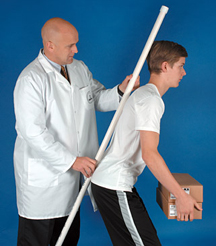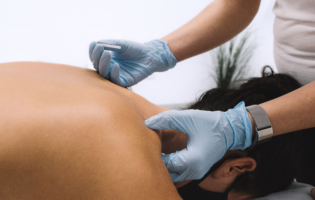Total Therapy Blog
The Start of Long-Term Back Health

If you’re like most Canadians, you’ve probably felt the twinge or ache of back pain at some point in time in your life. The question is, why does back pain occur? Understanding and addressing the “why” of low back pain is a key part to effectively treating it.
In most cases, the source of low back pain (LBP) is mechanical. Mechanical back pain is defined as pain that is a consequence of certain tissues being over-stressed – sometimes to the point of failure (e.g. a herniated disc). Repetitive spine bending/twisting, poor posture, and improper biomechanics can result in mechanical back pain. Therefore, an important part of treating and preventing LBP is learning how the body is supposed to move to minimize the daily stress on the spine.
An important concept to learn is how to maintain a neutral spine position as you move. Here are some examples:
 The Squat
The Squat
Many people quote the old saying “lift with your legs” when bending. Unfortunately this statement ignores the important details of how to actually lift properly. To minimize stress on the spine you need to “hinge from the hips.” This means that you keep your back in a neutral position while making your hips do the work. You can do a full squat to lift something off of the ground or a half squat to lean over the sink when brushing your teeth or to look into the fridge.
Start in an upright position and take a wide V-stance. Your low back should have a natural curve to it, with your hips, shoulders, and head aligned. To check your posture you can place a broomstick along your spine and touch the back of your head and the top of your tailbone. Do NOT flatten your back. Before you bend your knees, lead with the hips by sticking the butt out and then move into a squat. The broomstick should never lift off of your tailbone or head, and your low back should maintain its natural curve. Your knees should not go past your toes.
 The Golfer’s Lift
The Golfer’s Lift
This movement is useful for picking up smaller items and is often more convenient than performing a squat. Start upright and keep a neutral spine (you can test your posture with the same “broomstick” technique as described above). Pivot around the hip using the other leg for counterbalance and place the hand on a support surface. The spine never twists or bends. This movement can also be performed without a hand support for smaller lifts and once technique improves.
Keep in mind that these movements may not be appropriate for everyone. If you’re unsure, or you are experiencing an acute case of LBP, see a health care practitioner who specializes in spine rehabilitation – like your kinesiologist, physiotherapist, or chiropractor.
Remember to always think before you move. Perfecting these techniques in everyday life is the first step in developing good long-term back health.








Follow Us!
& Stay Up To Date
BLOG